
- Skukuza and Surrounds
- Phabeni Gate to Skukuza
- Paul Kruger Gate to Skukuza
- Skukuza to Lower Sabie
- Tshokwane to Satara
Albasini Ruins
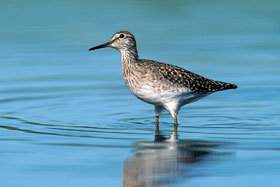 A fine spot to acclimatise to the Park and test the binoculars is the Albasini Ruins, 100m from Phabeni Gate. This was the homestead and primitive retail headquarters of João Albasini, the legendary Portuguese ivory trader who made and lost fortunes during his exploits in the lowveld during the 19th century. In the shade of Marulas, Knob-thorns, bushwillows and Jackal-berries are the modest ruins of his house.
A fine spot to acclimatise to the Park and test the binoculars is the Albasini Ruins, 100m from Phabeni Gate. This was the homestead and primitive retail headquarters of João Albasini, the legendary Portuguese ivory trader who made and lost fortunes during his exploits in the lowveld during the 19th century. In the shade of Marulas, Knob-thorns, bushwillows and Jackal-berries are the modest ruins of his house.
Southern Yellow-billed and Trumpeter Hornbills, bulbuls, greenbuls, parrots and turacos all frequent this site because of the trees and the nearby Phabeni Stream reed beds. Sightings here include the Southern Black Tit, African Paradise-Flycatcher and the Golden-tailed Woodpecker - the males of the latter species spar with their bills during territorial disputes. From Phabeni there are two main options when heading for Skukuza: the main tar road - the Doispane Road (S1) or the Upper Sabie River Drive (S3).
Doispane Road (S1)
From the Albasini Crossroads (S3/S1), the Doispane Road (S1) gently descends into the Sabie River Valley. To the south-east, Napi Boulders are visible over the relatively flat plains that roll into the distance. In summer there are scores of European Rollers in the mixed Marula woodland.
They arrive in mid-October and generally leave towards the end of March. Although they are usually seen on their own in the Park, they appear to flock together for their migratory journey back to their North African and eastern European breeding grounds. Hundreds of thousands of European Rollers are regularly seen in early April flying northwards along the East African coastline between Tanzania and Somalia. 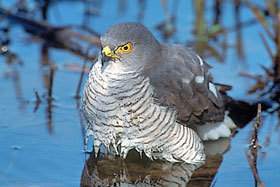 Nyamundwa Dam, approximately 10km from Phabeni, is best in the afternoon because access is from the west and so the sun is behind one.
Nyamundwa Dam, approximately 10km from Phabeni, is best in the afternoon because access is from the west and so the sun is behind one.
This is a favourite water hole for buffalo. Among the birds that can be seen here are the Blacksmith Lapwing*, Little Grebe*, Grey Heron, the ubiquitous Egyptian Goose and the less common Woolly-necked Stork. In summer, Lesser-striped Swallows and even Horus Swifts can be seen dipping over the water.
East of Nyamundwa Dam, the ecosystem shifts from open, sourveld grassland to woodland and dense thorn thickets interspersed with grassland. The S1 crosses several dry watercourses that lead into the Sabie River. Accipiters such as the Gabar Goshawk thrive in the dense woodland pockets alongside the open grassveld. East of the rocky hills at Wolhuter's Outspan (S4 turn-off to Paul Kruger Gate) the Knob-thorns dominate, and with them come the Southern Yellow-billed Hornbills.
Magic Guarris become more common and the landscape opens up extensively. An indicator of the more eastern Kruger environment is the Leadwood, which is apparent along drainage lines closer to Skukuza. Leadwoods are favoured nesting trees for birds, and are usually associated with good game-viewing because they thrive in the sweetveld loved by grazers.
The Doispane Road is a good winter drive because many of the higher altitude species such as the African Stone-Chat and Cape Batis migrate here between June and August to take advantage of the lowveld's ample food sources. The appearance of the Cape Batis in Kruger appears to coincide with particularly cold years. The Sabie River is also a thoroughfare for many birds of prey including the Brown Snake-Eagle and the Bateleur, which nest in the surrounding woodlands. There are sometimes Double-banded Sandgrouse feeding along the road edges in the vicinity of Skukuza.
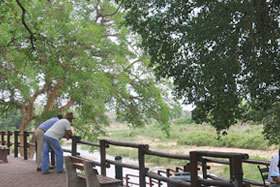 Skukuza Camp
Skukuza Camp
Skukuza is the 'capital' of Kruger and one of the best birding sites in the Park. Established as Sabi Bridge in the late 1890s near the confluence of the Sabie, N'waswitshaka and Sand Rivers, it was originally the headquarters of the old Sabi Game Reserve. This is where James Stevenson-Hamilton took up his post and began to transform the lowveld from an over-hunted, disease-ridden outback into one of the world's top game reserves. Over time, birds have responded to the human development at Skukuza.
The combination of irrigated lawns, close planting of colourful, flowering, indigenous trees and the proximity of the riverine forest have provided birds with a habitat in which new cycles of breeding and feeding have been established. Ian Whyte, who was based at Skukuza between 1970 and 2002, says that during that time the area has become much more heavily forested.
'When I first moved here one barely saw a Yellow-fronted Tinkerbird* or a Gorgeous Bush-Shrike - they are now quite commonly seen. The same goes for the African Goshawk - it was never assoicated with Skukuza. Now one hears them there every other day.' The walkway along the Sabie River is the best birding spot in Skukuza, particularly in early summer when the Sausage (Kigelia africana) and Weeping Boer-bean (Schotia brachypetala) trees are in flower. They are always the scene for sunbird activity. Apart from the common Collared Sunbird, Skukuza is also known for the White-bellied and Marico Sunbirds. Look out for the Little Bee-eater, the world's smallest bee-eater, which hawks bees and wasps attracted to the restaurant area by sugary food.
Walk along the river bank during the early evening when bats emerge. In summer, the light is still good enough to see the Eurasian Hobbies chasing bats and occasionally, the rarely seen Bat Hawk joins in the hunt. According to SA Birding, this section of the Sabie River is one of the few places in Kruger where it's possible to see the African Goshawk performing its early morning displays. The Gabar Goshawk sometimes raids the weaver nests in the Sycamore Figs in front of the Skukuza restaurant.
The Sycamore Figs (Ficus sycomorus) along the river are a major drawcard for birds. When in fruit they attract the African Green-Pigeon and Purple-crested Turaco* as well as parrots, mousebirds, barbets, bulbuls and starlings. There are large colonies of Village Weavers and Lesser Masked-Weavers that nest in these trees, while the less common Spectacled Weaver is also present.
The reed banks across the river are home to Half-collared Kingfishers and Red-faced Cisticolas while Red-backed and Bronze Mannikins, and the Orange-breasted, Grey-headed and Gorgeous Bush-Shrikes may be seen. The Marsh Warbler* is also sometimes seen in the bullrushes along the Sabie River banks. Birding author Callan Cohen suggests one looks in the tall Umbrella Acacias near the campsite for the Grey Tit-Flycatcher and Burnt-necked Eremomela and in the thick bush near the Selati Restaurant for the robins - the White-throated, White-browed and Red-capped Robin-Chats* and the White-browed and Bearded Scrub-Robins. Besides the Grey Tit-Flycatcher, there are six other species of flycatcher at Skukuza for those up to the challenge - the African Paradise, Southern Black, African Dusky, Spotted, Ashy* and Pale* Flycatchers.
Human activity also attracts birds, which are always on the look out for a free meal. Starlings, weavers and bulbuls can be a particular nuisance outside the restaurant and fast-food area as they beg audaciously and fight each other noisily for scraps. At night when the lights come on and the fig tree outside the restaurant is lit up, Woodland Kingfishers often come in close to hunt the insects drawn by the glow.
From the walkway one can sometimes see White-breasted and Reed Cormorants diving for fish in the deeper pools of this section of the Sabie River. Natural history expert Dr Andrew Deacon says that if one watches cormorants closely enough, one will notice that the Reed Cormorant dives at shorter intervals than the White-breasted Cormorant - that's because it feeds on smaller fish, while the latter dives less regularly and stays underwater longer because it catches larger fish such as kurper and yellowfish. Among the tamer woodland birds at Skukuza are the African Hoopoe and the Greater Blue-eared Starling, which is very similar in appearance to the Cape Glossy Starling.
The Cape Glossy Starling, with its bright orange eyes, is an aggressive forager. Its nature is to rely on other animals to help it find food. It is often found near large animals, hawking insects they disturb. It benefits hippo and sable by removing ectoparasites from their skin. Three woodpeckers commonly seen at Skukuza are the Golden-tailed, Bearded and Cardinal species, while the Thick-billed Cuckoo is a regular summer visitor. African Palm-Swifts nest in the palm trees and buildings in the camp, while Lesser Striped Swallows nest in the eaves of the camp buildings.
Phabeni to Skukuza via Sabie River Drive (S3)
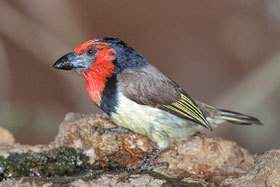 An interesting, unpredictable birding route is to take the upper Sabie River Drive (S3) which follows the Sabie River for 24km before it joins the tar road near Paul Kruger Gate. Although there are only a few, direct river-vantage points along this drive, there are often good sightings because the Sabie River environment supports so much birdlife.
An interesting, unpredictable birding route is to take the upper Sabie River Drive (S3) which follows the Sabie River for 24km before it joins the tar road near Paul Kruger Gate. Although there are only a few, direct river-vantage points along this drive, there are often good sightings because the Sabie River environment supports so much birdlife.
Among the raptors in the gallery forest are the rare Black and more common Little Sparrowhawks, African Cuckoo Hawk and African Goshawk whose manoeuvrability through the forest canopy gives them an edge over their larger counterparts. This is not a drive for bushveld purists as development on the other side of the Sabie River outside Kruger has diminished the sense of untouched wilderness and the feeling of human encroachment is all too close.
The Sabie is one of the country's most ecologically valuable watercourses because it is a cool river running through a hot area. Development in the upper Sabie catchment may threaten the river's biodiversity.
PRIVATE CAMPS AROUND SKUKUZA
Rhino Post Game Lodge 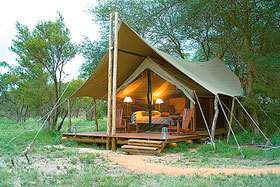
Mutlumuvi is a pristine 12 000 ha private concession just north of Skukuza that specialises in walking safaris. This area has one of the highest populations of white rhino in Kruger and there is a good chance of seeing these animals during a walk.
Lowveld birder Alf Curling has noted a rare colour form of the Black-collared Barbet with a yellow head that seems to occur nowhere else in Kruger other than in the Mutlumuvi Concession and the bush north of Skukuza. An Egyptian Vulture - an extremely rare occurence in Kruger - has also been seen at Mutlumuvi. There are two main camps in the Concession - the upmarket Rhino Post Game Lodge, which has eight luxury, thatched chalets, each with a private deck overlooking the thick Mutlumuvi River bush, and Plains Camp, an eight-bed, semi-luxury safari camp.
There is also a sleepout shelter in the riverine forest. One is likely to have excellent sightings of both the Bateleur and the African Fish-Eagle in the Concession.
Tinga Safari Lodges
Tinga's Concession is well positioned between the Sabie and Sand Rivers. Tinga Narina is 13km from Paul Kruger Gate, while Tinga Legends is 7km from Skukuza 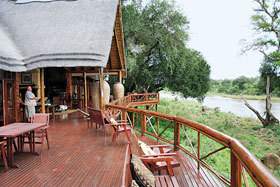 in what used to be the old Jakkalsbessie Concession. Tinga has rights to 35km of Sabie River frontage and the birding can be quite dramatic.
in what used to be the old Jakkalsbessie Concession. Tinga has rights to 35km of Sabie River frontage and the birding can be quite dramatic.
Tinga guides claim to have seen a Martial Eagle seizing a baby impala and a Tawny Eagle attacking a juvenile baboon. There are two lodges - Legends and Narina, each of which consists of nine luxury suites with their own private viewing decks and plunge pools. Legends overlooks the Sabie River and has a great wooden walkway between the chalets, which are surrounded by Leadwoods, Black-monkey Acacia and Sycamore Figs. This stretch of the Sabie has steep banks, which provide ideal nesting sites for White-fronted Bee-eaters and a variety of kingfishers - the Malachite, Half-collared, Pied and Giant Kingfishers. The wooden debris from the 2000 floods has increased the woodpecker population in the vicinity.
Narina is built on stilts in the riverine bush a few kilometres to the west, and is named after the Narina Trogon, a shy and secretive, brightly-coloured forest bird that inhabits the denser pockets of riverine bush along the Sabie. Both lodges offer game drives and guided bush walks, and the area is renowned as big cat territory with frequent sightings of lion and leopard.
Among Kruger's less common birds seen in the Tinga Concession are the African Finfoot, African Crowned Eagle, Pel's Fishing-Owl, African Goshawk, Shikra* and the Southern Black Flycatcher. One of the few verified nesting sites of the Black Sparrowhawk in Kruger was recorded close to where Tinga Narina now stands.

